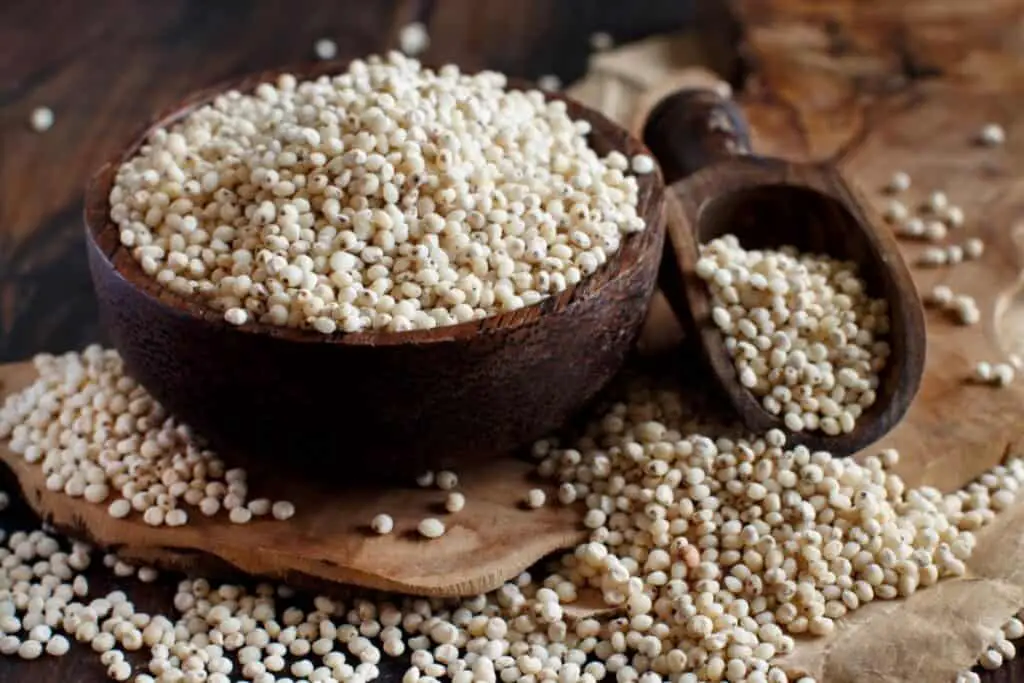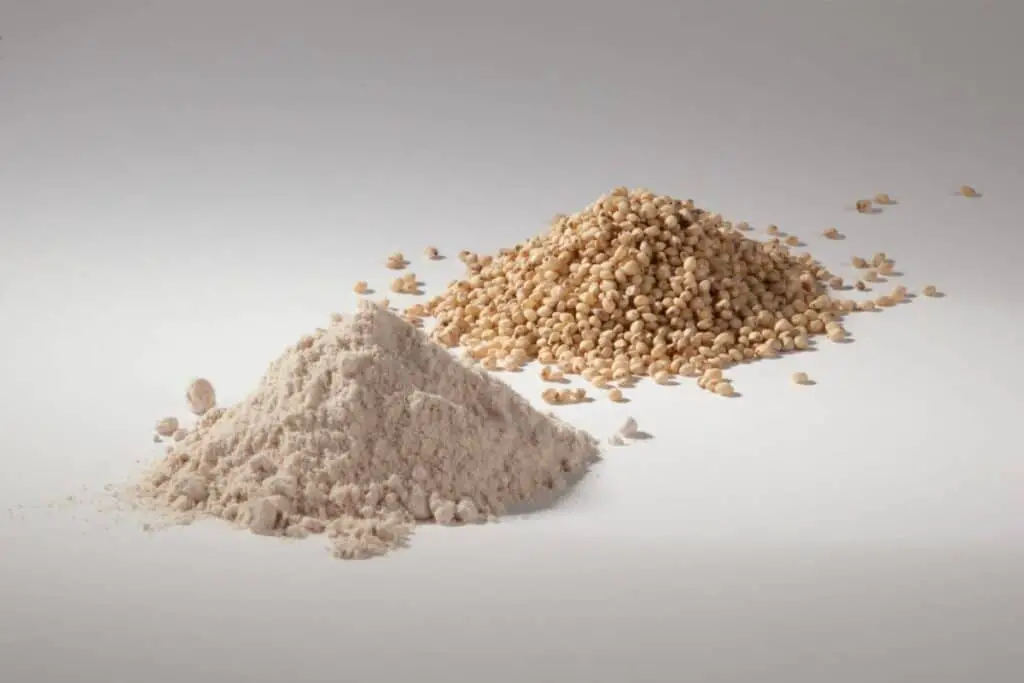Sorghum flour is a widely used gluten-free flour that is commonly used as a wheat flour alternative.
Due to its gluten-free quality and its unique taste and texture, it continues to grow in popularity. This flour can be substituted for all or part of the regular wheat flour in any recipe.

When it comes to finding a versatile and effective flour, it can be difficult to know which to choose.
This post shares everything you need to know about this versatile flour, how it is made, and most importantly, how it can be used.
What Is Sorghum Flour?
Sorghum flour is a type of flour that is commonly used as a gluten-free ingredient in baked goods and is widely recognized as a popular cereal grain.
It consists of a considerably fine consistency that works to create a light and delicate texture when it is added as an ingredient.
How Is Sorghum Flour Made?
Sorghum flour consists of incredibly fine ground sorghum kernels. Flours are available in different forms including white, brown, red, black, and bicolor varieties. The color of the flour depends on the amount of processing the grains undergo.
For instance, whole grain sorghum consists of finely ground whole grains that contain the endosperm, bran, and germ whereas pearl or white grain sorghum is generally stripped of the germ and bran which gives it a lighter and more delicate flavor and consistency.
Black Sorghum Flour
Black sorghum flour is produced by grinding the whole kernel into a powder form. This process removes the outer husk from the grain while leaving the inner germ intact.
During this process, the starch granules within the germ are broken down further into smaller particles. These smaller particles give the flour a finer consistency than other types of sorghum flour.
Black sorghum is known to be significantly nutrient-rich and is commonly used for baking due to its unique texture, nutritional profile, and dark-rich color.
What Does Sorghum Flour Taste Like?
This flour is said to consist of a slightly sweet flavor. Hence, it is commonly used for making sweet baked goods and pastries as its flavor is nicely complemented by sweet and aromatic spiced flavors.
Other Names For Sorghum Flour
There are several types of this flour and each offers something unique. Due to its versatility, there are several names for the different types. The most common names include:
- Whole-grain sorghum
- Pearl grain sorghum
- Jowar flour
- Millet
Can I Make It At Home?

Making any flour at home can be a bit of work, but sorghum is one of the easiest flours to make. It’s also very versatile in baking and cooking. Making this flour at home will save you money and time as well as give you more control over your ingredients.
All that’s required for making this flour at home is grinding whole sorghum grain into flour using a food processor or blender. The process takes about 5 minutes, and it’s easy to do. Once ground, your flour is ready to use.
Sorghum Flour Substitutes
Sometimes, we don’t always have the ingredients we want to use at hand. Here are a couple of pantry alternatives that can be used as substitutes:
- Almond Flour
- Rice flour
- Potato starch
- Tapioca starch
- Arrowroot powder
All the listed substitutes above can be found in most grocery stores. They all contain similar amounts of protein and carbohydrates, so they can be substituted 1-to-1 with sorghum.
Sorghum Flour Nutrition
This type of flour is considered to be significantly nutrient-rich and contains powerful antioxidants that make it a healthy ingredient choice. It contains:
- Calories 361
- Total fat 3g
- Sodium 4 mg
- Total carbohydrates 77g
- Fiber 6.6g
- Sugars 2g
- Protein 8g
The nutrient profile of sorghum flour is comparable to other gluten-free flours such as rice flour and tapioca starch. Sorghum stands to have a higher level of fiber than wheat flour making it an excellent choice for those looking to maintain a healthy diet.
Is It Healthy?
Due to its nutrition-rich profile, sorghum flour is considered a healthier alternative to wheat flour. It has been shown to reduce cholesterol levels, improve blood sugar balance, and lower the risk of heart disease due to its antioxidant properties that are said to be effective in reducing inflammation.
Is Sorghum Flour Safe For Gluten-Free?
Sorghum flour is one of the best gluten-free flours available today. It’s made from a type of grain called sorghum which does not produce gluten. This means that its flour is safe for people who suffer from celiac disease or gluten intolerance.
Is Sorghum Flour Keto-Friendly?
A ketogenic diet requires a high amount of dietary fats and low carb intake. Though nutrient-rich, sorghum flour contains a high amount of net carbs and should therefore be used minimally in a keto diet. For this reason, sorghum isn’t recommended for keto diets. However, if you’re looking to incorporate some sorghum into your diet, there are many ways to limit the impact on your ketone levels.
How Many Carbs?
100 grams of sorghum flour contains 77.5g of total carbohydrates. This makes it slightly less carbohydrate-dense than other gluten-free flours.
Is Sorghum Flour Good For Diabetics?
Diabetes is characterized as a disease that causes glucose (blood sugar) levels to become too high. High glucose levels can cause serious health problems. People with diabetes need to carefully monitor their blood sugar levels.
Sorghum flour is considered to be safe for diabetics as it doesn’t raise blood sugar levels. Instead, this flour is said to contain antioxidant properties that are known to protect against hyperglycemia and oxidative stress.
Hence, sorghum stands to be an effective way to prevent diabetic complications as it has a low glycemic index.
What Can I Make With Sorghum Flour?
You can use this flour in any recipe that calls for regular flour. The only thing to keep in mind is that this flour tends to absorb moisture more readily than regular flour.
Therefore, when substituting sorghum for regular flour, add extra liquid to compensate for the increased absorption rate.
When it comes to using sorghum flour as a gluten-free alternative, here are some recipes that would work well:
- Biscuits
- Cakes
- Cookies
- Pancakes
- Pastries
- Pie crust
- Waffles
The options of what you can use this workhorse flour for are endless!
Cooking With Sorghum

Cooking with sorghum flour is easy. It stands to be a versatile and nutritious ingredient that will help you create delicious dishes.
When it comes to cooking with sorghum, it’s important to consider the flour’s consistency as it may affect how the dish turns out. If you want to cook with it, you’ll need to adjust the quantity of water accordingly.
You can also experiment with different types of liquids such as milk, broth, coconut oil, etc.
Baking With Sorghum Flour
Like cooking, baking with sorghum flour requires careful attention. Baking with sorghum requires a lot of experimentation because the flour absorbs moisture easily.
To ensure that your baked goods turn out right, try adding more liquid to compensate for the additional water absorbed by the flour.
In addition, it’s important to note that sorghum flour contains starch which means that it could potentially cause dryness in baked goods.
So, once again, it’s best to experiment with different amounts of liquid and temperature to find the perfect balance between moist and dry.
However, sorghum flour is a great choice for baking as it offers a nutritionally rich and delicious option for those who have celiac disease or gluten intolerance.
How Long Does Sorghum Flour Last?
Sorghum flour can last a considerably long period of time. It has a shelf life of two months. However, when stored correctly in a tightly sealed container and refrigerated, its life can be extended to up to eight months.
To effectively store this flour, keep it in a cool and dry location. This will reduce the chances of mold developing on the flour.
Where To Buy Sorghum Flour
Sorghum flour can be found in supermarkets, online retail stores, and local grocery stores. Some of the most popular destinations for buying this flour include:
- Amazon
- Walmart
- Whole Foods Market
- Costco
- Target
- Kroger
When it comes to sourcing high-quality flour, be sure to look out for brands that are certified organic. Also, make sure that the product is free from additives like preservatives and other artificial ingredients.
Takeaway
Overall, sorghum flour has many uses and applications. As a gluten-free alternative, it provides a nutrient-dense and healthy food option.
For people with celiac disease or gluten sensitivity, this flour can be used as a healthier substitute.
Additionally, this flour has a wide variety of culinary uses including bread, cakes, cookies, pies, waffles, pancakes, biscuits, and pastries due to its delicate consistency and sweet flavor.
Sorghum flour stands to be a versatile ingredient that can add depth and complexity to any recipe.
